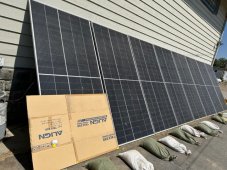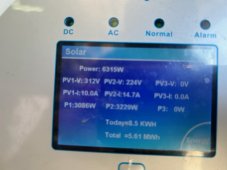In the arrays constructed here, how are the bypass diodes arranged? In my testing (with a far smaller number of panels) I found that different shade patterns had wildly varying impacts depending on how the shade crossed PV cells that were covered by the same bypass diode.
(edit)
I was thinking about this more last night as what is observed here doesn't make sense to me given what a bypass diode would do. One thing that occurs to me is that your array is much larger than the 2-panel arrays that I used in my testing. That means that when the bypass diode kicks in, it will be carrying a lot more power. Is it possible that the bypass diodes in the shaded panels have become damaged? If one hooks up a volt meter across the shaded panel, what sort of voltage drop is seen? If the diodes are working properly, the voltage drop should be close to zero. Also current going into the shaded panel should be about the same as the current leaving the shaded panel. From an electrical perspective, the shaded panel should look the same as a simple wire. If it isn't that would suggest that something is wrong with the bypass diodes.
(edit2)
Sorry to keep adding on, but I think I just realized where the difference lies. It comes down to size. My test scenario used a tiny 2-panel array. Your arrays are larger - looks like 10 panels in series. The issue is whether the bypass diodes in the shaded panel remove the entire panel from the series, or just some of the cells in the panel. If the shade covers all the bypass strings in the panel, then the panel is effectively completely removed from the array and power drops by the proportion of lost panels. In a 2-panel array, losing one panel results in a 50% power reduction. In a 10-panel array, the power reduction is 10%. But if the shade only covers some of the bypass strings in the panel, then the panel is still in the series, but with a reduced number of PV cells, which means a reduced amperage. So if the shade removes 1 of 3 strings in a panel, then the amperage is reduced by 33%. Since serial arrays rely on having consistent amperage across all panels, reducing amperage in one panel by 33% reduces the amperage across the entire array by about 33%. In a 2-panel system, a 33% reduction is smaller than the 50% reduction for losing an entire panel. But in a 10-panel serial array, that 33% reduction across the array is a much larger impact than the 10% reduction for completely losing a panel.
This would tend to suggest that for larger arrays there is a clear advantage for parallel configurations. As long as the shaded cells receive enough light to stay close to the nominal Voc (about 200 W/m2 from what I can find in the online literature) then a partially shaded panel would maintain about the same Voc and simply produce less current. In a larger parallel array, as long as each panel is producing about the same voltage a reduction in current from one panel has a much smaller impact on the entire array.
(edit)
I was thinking about this more last night as what is observed here doesn't make sense to me given what a bypass diode would do. One thing that occurs to me is that your array is much larger than the 2-panel arrays that I used in my testing. That means that when the bypass diode kicks in, it will be carrying a lot more power. Is it possible that the bypass diodes in the shaded panels have become damaged? If one hooks up a volt meter across the shaded panel, what sort of voltage drop is seen? If the diodes are working properly, the voltage drop should be close to zero. Also current going into the shaded panel should be about the same as the current leaving the shaded panel. From an electrical perspective, the shaded panel should look the same as a simple wire. If it isn't that would suggest that something is wrong with the bypass diodes.
(edit2)
Sorry to keep adding on, but I think I just realized where the difference lies. It comes down to size. My test scenario used a tiny 2-panel array. Your arrays are larger - looks like 10 panels in series. The issue is whether the bypass diodes in the shaded panel remove the entire panel from the series, or just some of the cells in the panel. If the shade covers all the bypass strings in the panel, then the panel is effectively completely removed from the array and power drops by the proportion of lost panels. In a 2-panel array, losing one panel results in a 50% power reduction. In a 10-panel array, the power reduction is 10%. But if the shade only covers some of the bypass strings in the panel, then the panel is still in the series, but with a reduced number of PV cells, which means a reduced amperage. So if the shade removes 1 of 3 strings in a panel, then the amperage is reduced by 33%. Since serial arrays rely on having consistent amperage across all panels, reducing amperage in one panel by 33% reduces the amperage across the entire array by about 33%. In a 2-panel system, a 33% reduction is smaller than the 50% reduction for losing an entire panel. But in a 10-panel serial array, that 33% reduction across the array is a much larger impact than the 10% reduction for completely losing a panel.
This would tend to suggest that for larger arrays there is a clear advantage for parallel configurations. As long as the shaded cells receive enough light to stay close to the nominal Voc (about 200 W/m2 from what I can find in the online literature) then a partially shaded panel would maintain about the same Voc and simply produce less current. In a larger parallel array, as long as each panel is producing about the same voltage a reduction in current from one panel has a much smaller impact on the entire array.
Last edited:






